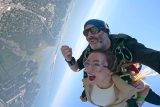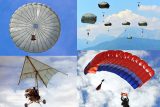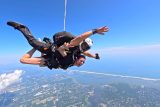The Science Behind Skydiving Without a Parachute
Skydiving
Posted by: Long Island Skydiving Center
9 years ago
Photo by Benjamin Forde | Fordesign
At Long Island Skydiving Center, we are definitely in favor of parachutes. We love them, in fact. We certainly don’t endorse the idea of skydiving without a parachute. That said: we’re enormously proud of Luke Aikins, who recently decided to forego using his in a landmark maneuver that will forever go down in the history books as one of skydiving’s greatest stunts.
Luke Aikin’s Background
Luke, despite how wild his idea sounds and looks, is by no means “crazy.” He’s well-respected, prepped the heck out of the stunt and used lots of science (and aviation technology) to achieve his ends. The son of a regular skydiving dynasty, with three generations of jumpers successively out-doing each other’s accomplishments. Luke himself holds three skydiving world records. A consummate professional, Luke has personally helped train the cream of the skydiving crop, traveling widely to do so. Luke’s expertise was instrumental, in fact, in planning the Red Bull Stratos jump performed by Felix Baumgartner in 2012.
Preparation for Skydiving Without Parachute
Aikins had 18,000 jumps under his belt–and 25 years of parachuting, both sky and BASE–at the time of the no-parachute stunt, but it wasn’t just experience that was going to get him through in one piece. In fact, the stunt took Luke and his team more than two years to plan.
The jump itself was necessarily simple. In essence, this was a single-orientation, belly-to-earth freefall from a Cessna to a 100-by-100-foot net, suspended between four 200-foot cranes. He planned to perform his exit from an altitude of 25,000 feet, carrying a GPS, a method of communication, and an oxygen tank (to use for the first 10,000 feet or so). Conspicuously absent was the inclusion of a parachute, a wingsuit, or any other apparatus that could slow him down if something went wrong. If it had, it would have been awful: lots of Aikins’ friends and family (including his skydiving-instructor wife and their four-year-old son) were gathered on the ground around the net.
The Science Behind It
The planned skydive itself was pretty lo-fi, in order to limit the number of variables in the way. For us, it’s the sciencey part that’s the fun part. Take the material of the netting, for instance. Woven out of completely un-springy Spectra, the net was by no means a trampoline. It wasn’t made to bounce at all; instead, compressed-air cartridges were set up to fire when Luke touched the net’s surface. These were constructed to lower at a calculated rate, in order to catch him like you might catch an egg that was thrown at you–matching the fall rate, then slowing down gently over time and distance. Trampoline-style bounce dynamics would have flung him out into the desert, you see.
The lights he used are worth talking about, too. From higher altitudes, Luke’s plan was to use a GPS to get into the ballpark; from the point he was within visual contact of the landing area, he needed something much more precise. For this, Luke and his team turned to aviation technology, creating a light system that resembles the PAPI and VASI light systems used by aircraft pilots to line up their approaches. These lights indicated any changes he needed to make in order to be set up over the dead center of the net.
All the prep paid off. On June 30, 2016, Luke successfully made his parachute-less jump and landed safely in the middle of the net, walking away on his own two feet with a huge smile on his face to kiss his wife and snuggle his son. His amazing success sure hasn’t inspired us to put away our nylon, but we’re all high-fives for Luke!
Categories:
You May Be Interested In:

Skydiving After LASIK: What You Need to Know
7 months ago by Long Island Skydiving Center

What Parachute Types Are There?
8 months ago by Long Island Skydiving Center

How Dangerous is Tandem Skydiving?
9 months ago by Long Island Skydiving Center

Nervous About Skydiving? Here Are Our Top 6 Tips!
10 months ago by Long Island Skydiving Center